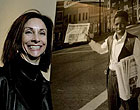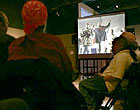 |
Jeannette Lindsay didn't take the skeptical responses personally when she told people seven years ago that she wanted to make a documentary film about the thriving arts scene in Leimert Park. After all, she knew nothing about filmmaking. She had never even operated a home video camera. But if nothing else, she was determined. So she bought a small digital camcorder and began hanging around jazz clubs, galleries and cafes in the southwest Los Angeles neighborhood, which for years has been a hub of African American art and culture. To finance her project, which cost about $20,000, she worked as an accountant. On Saturday afternoon, Lindsay's film, "Leimert Park: The Story of a Village in South-Central L.A.," screened before an enthusiastic audience at the California African American Museum in Exposition Park. "This was all about the value of art as an integral part of our community," Lindsay said before the screening. "The film is a celebration of Leimert Park and its artists." |
||
| Click to Enlarge | |||
 |
|||
| Click to Enlarge | |||
"I'm glad somebody had a chance to tell this important story," said an artist known as Ramsees, who for two decades sold stained-glass art and sculptures from his Degnan Boulevard studio.
Like a number of the area's grass-roots artists, Ramsees closed his studio several years ago after redevelopment projects led to rent increases.
Developed in the late 1920s, Leimert Park was restricted to whites and known for its golf course and several airstrips. Howard Hughes learned to fly there.
Today it is a place where people stroll the streets at night, browse art galleries or sit at sidewalk cafes and play dominoes while listening to jazz.
Lindsay's documentary memorializes that creative energy through the words and performances of Leimert Park's denizens, including several who died while the project was being developed.
They include the late Richard Fulton, a local symbol of perseverance and success. He rose from being homeless on skid row to becoming the owner of 5th Street Dick's Coffee Co., a landmark cafe and jazz club that opened on West 43rd Place two days before riots erupted after the Rodney G. King police brutality verdict in 1992.
Some of Fulton's first customers were the National Guard troops who patrolled while rioters looted and burned businesses surrounding Leimert Park. In the film, Fulton says the rioting helped forge a bond among area artists, who stood guard over the businesses.
"We all became a community right then and there," Fulton said.
There is also vintage performance footage of the late jazz drummer Billy Higgins and the late musician Horace Tapscott, who directed the renowned Pan African People's Arkestra.
Other artists featured in the film include poet Kamau Daaood, who operates the World Stage, a performance and meeting gallery that opened on Degnan Boulevard in 1989.
Lindsay first learned about Leimert Park while taking a music appreciation class at Antioch University in Culver City. As part of an assignment, she wrote a proposal for a documentary film on the community.
Then she read several books about filmmaking and operating cameras.
Before long, she was in Leimert Park, soaking up the culture and interviewing the artists. They welcomed her and were glad to help out, she said.
"I could never have made this project without the support of the people of Leimert Park," said Lindsay, 45, who lives in Pasadena.
At times, it was a frustrating experience as she struggled to learn the complexities of film production and editing, which she did on her home computer.
"There were times when I wanted to throw my computer out the window," she said.
But Lindsay said she kept going, in large part, because of the artists she had met. "Seeing what these people had created gave me the inspiration," she said.